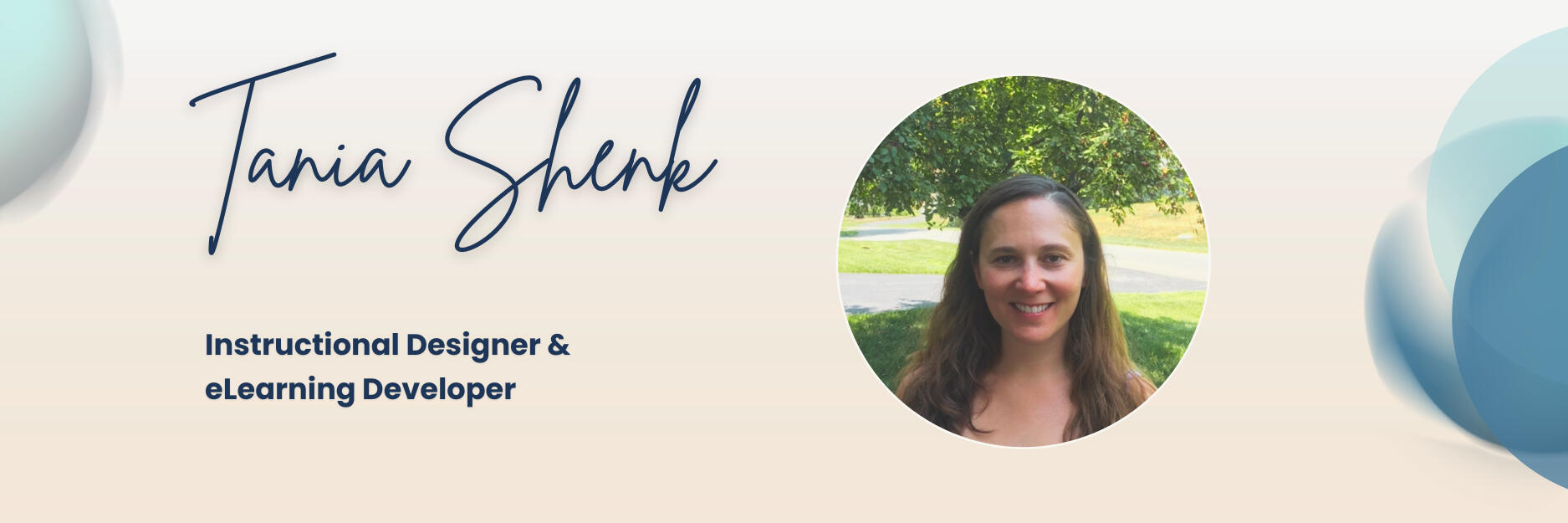
Hello, I'm Tania Shenk
I design learning that's simple, respectful of people’s time, and built to get results. Whether it’s soft skills, compliance, safety, or onboarding, I focus on creating practical tools that help people do their jobs better, so they feel more confident, and the business sees measurable impact.
Here’s what I build into every learning experience.
People Focus

Scenario Practice

Business Impact

Copyright © 2025 | Designed by Tania Shenk | Texas
About
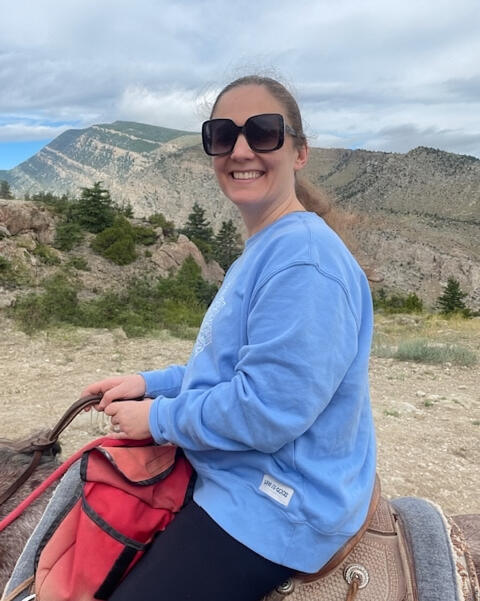
A quiet climb, some open space, and time to think.
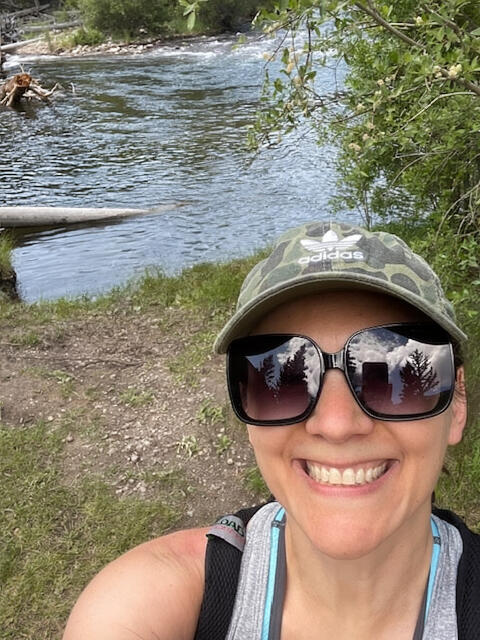
Lost the bear spray in mile one. Spent the rest of the hike listening hard.

Great ideas need great company. Mine comes with floppy ears and muddy paws.
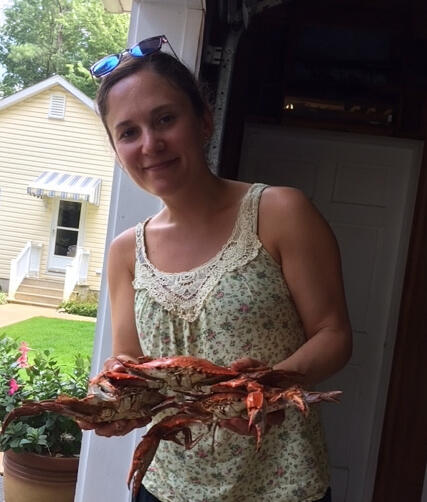
My roots? A little Old Bay, a lot of crabs, and endless stories told with messy hands.
Copyright © 2025 | Designed by Tania Shenk | Texas
Design Process
My approach to designing learning solutions is iterative and collaborative, moving through multiple stages with frequent client touchpoints to ensure alignment throughout the process.
This is how I solve learning problems and create engaging training that helps people do their jobs better.

Understand the challenge:
I ask what's standing in the way and work with stakeholders to uncover the real performance issue so we solve the right problem.

Map what success looks like:
I define what success looks like on the job by focusing on actions, not just answers, so people can make the right call when it counts.

Build with intention:
I storyboard, prototype, and test early to make sure everything feels useful and aligned with the business goals.

Layer in feedback:
I add coaching and reflection so learners can practice safely—and build confidence before going live.

Refine and deliver:
I smooth the flow, check accessibility, and make sure the course supports the people and the performance it was meant to serve.
Click the button below to see how I bring those values to life in real client-ready projects.
Copyright © 2025 | Designed by Tania Shenk | Texas
Featured Projects

Scenario-based training for Customer Success Managers
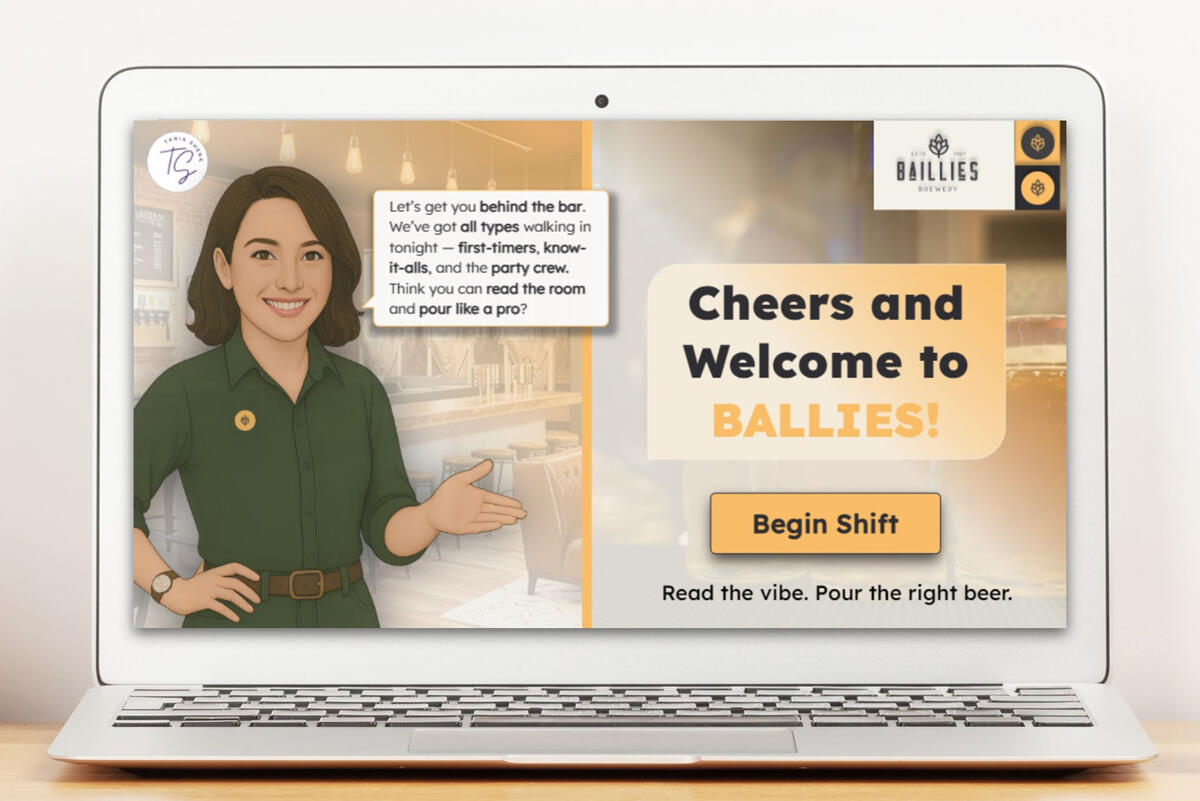
Gamified learning with realistic guest interactions

Interactive onboarding for first-time homebuyers
Copyright © 2025 | Designed by Tania Shenk | Texas
Turning Mistakes Into Opportunities
Helping newer and underperforming Customer Success Managers (CSMs) rebuild trust, reduce churn, and strengthen client relationships

Note: EdTech Solutions is a fictional SaaS company created for the purpose of this portfolio. This project simulates a realistic business challenge and shows how I would solve it through targeted instructional design.
The Challenge
EdTech Solutions is a growing SaaS company that partners with K–12 districts to deliver digital learning platforms, analytics tools, and implementation support. Their mission is to help school systems drive better outcomes through technology that is practical, scalable, and educator-friendly.Within the Customer Success team, a performance gap had started to emerge. While seasoned reps were managing well, newer hires and underperforming Customer Success Managers (CSMs) were struggling to regain trust after client missteps. These moments often led to avoidable churn, low CSAT scores, and missed renewal opportunities. Many CSMs lacked the strategies and confidence to navigate difficult conversations, analyze risk signals, and re-engage clients before accounts were lost.Leadership needed a targeted solution tailored to those managing high-risk accounts. The goal was to reduce churn by at least 5% within six months, improve client satisfaction, and increase long-term account value.
The Design
This eLearning course was designed to give underperforming CSMs practical, repeatable strategies they could apply right away. It targeted three high-impact areas linked to churn risk: handling difficult conversations, writing professional emails, and spotting subtle client cues that signal when to reengage.Each module focused on realistic, performance-based tasks. Learners started with a branching scenario featuring Megan, a CSM navigating a tough client interaction. Every choice led to different outcomes, illustrating how tone, timing, and ownership influence trust and recovery.In the second section, learners honed their communication skills by sorting examples and non-examples of professional email writing. They analyzed how tone, clarity, and content affected client satisfaction and retention–building awareness of how even small language shifts can either repair or erode trust.The final section placed learners in a simulated inbox, where they flagged follow-up tasks and identified risk signals. These quick-hit interactions helped build habits around recognizing client cues and responding proactively, before accounts were lost.Throughout the course, coaching moments helped learners reflect on their choices, and layered feedback explained not just what was right or wrong, but why it mattered. The experience prioritized action over recall, giving CSMs the confidence to apply what they learned in real client situations.
The Development
This course was built in Articulate Storyline using layers, branching logic, and true or false variables to drive interactive experiences and track learner decisions across each scenario.To create a realistic and responsive flow, I used customized visual feedback, dynamic state changes, and conditional triggers to mirror the feel of real time coaching. Coaching audio was layered in at key points to reinforce tone, strategy, and confidence building moments. Closed captions were included to support accessibility.The simulated inbox was built using motion paths, variables, and triggers to allow task tracking and reset behaviors. The branching email scenario and tone matching practice were prototyped and tested to ensure each path felt logical, intuitive, and learner friendly.Throughout development, I prioritized smooth user experience, professional polish, and alignment to real CSM workflows so the course would feel like a natural extension of the learner’s day to day work, not a generic training module.
Copyright © 2025 | Designed by Tania Shenk | Texas
Mastering the Art of Beertending
An interactive, scenario-based course that helps bartenders build confidence, adjust their tone, and deliver standout guest experiences
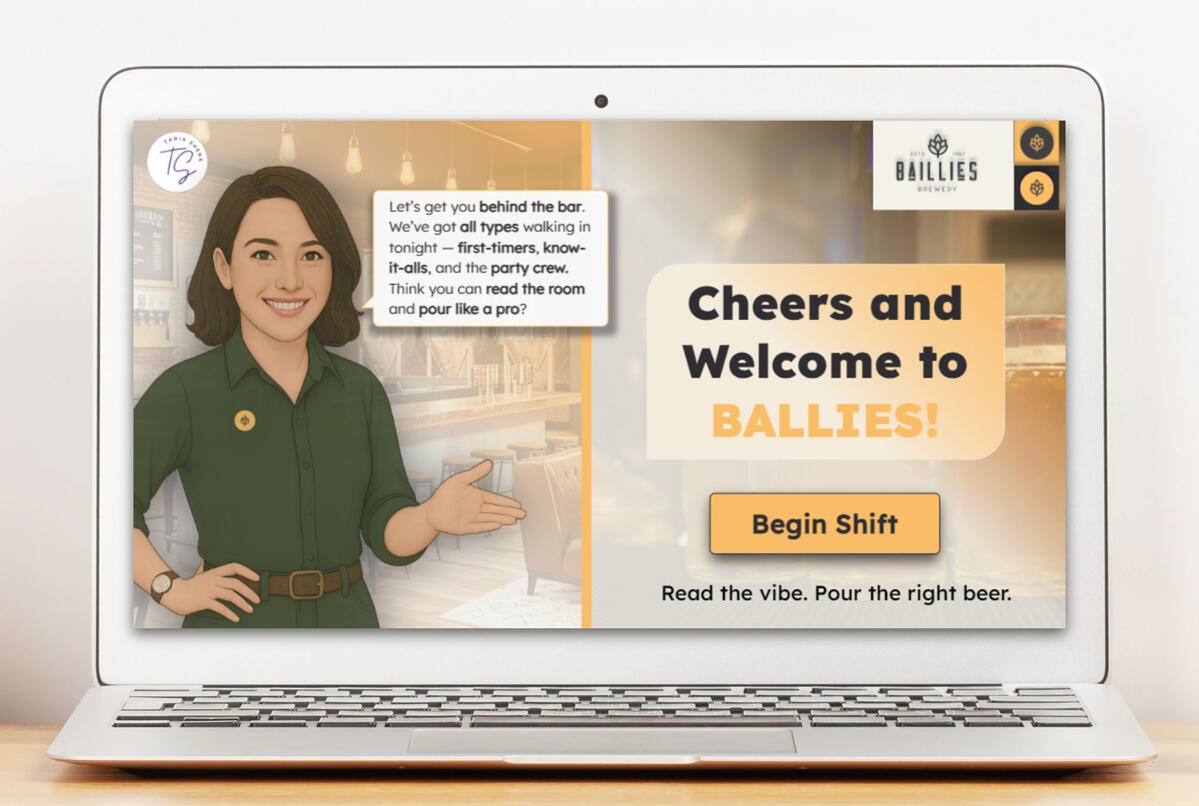
The Challenge
In any taproom, great service isn’t just about pouring the right beer–it’s about reading the room, matching the vibe, and making guests feel seen. But those soft skills often get skipped in standard onboarding.For this challenge, I focused on a common training gap: helping bartenders navigate different guest personalities while staying confident, conversational, and in control. The goal was to give learners practical tools to improve how they read guests, recommend products, and follow up–all in the middle of a busy shift.Rather than teaching generic hospitality tips, I wanted learners to practice the kinds of decisions that actually show up behind the bar: What do you say to a nervous first-timer? How do you redirect a rowdy regular without killing the mood? What if you offer the wrong beer–can you recover?This course was my way of turning those everyday moments into real learning opportunities–ones that could build trust, maximize guest satisfaction, and keep the service flowing.
The Design
This course was built around three distinct guest personas, each based on real-world taproom interactions. I crafted scenarios that would feel familiar to bartenders–managing a first-timer’s nerves, navigating a beer enthusiast’s high expectations, and keeping the party crowd happy without losing control.Each guest interaction included two key challenges. First, learners had to match the right beer based on subtle clues in the guest’s words and tone. Then, they had to choose an appropriate follow-up behavior to keep the conversation flowing. Every choice triggered immediate feedback–both visual and auditory–so learners could see and hear how their decisions played out.To help learners improve, each moment of feedback explained not just what happened, but why it mattered. This gave them space to reflect, adjust their approach, and try again. A token system added a layer of motivation, with up to three tokens per guest earned through accurate and timely choices. These tokens carried through the course and impacted a final debrief with the bar manager.The tone-matching, coaching moments, and decision-based practice were all designed to help bartenders improve their timing, delivery, and confidence–skills that directly affect guest satisfaction and repeat business.
The Development
This course was built in Articulate Storyline using layers, branching logic, and variables to create a smooth, decision-based experience. I mapped each guest interaction with a mix of character states, motion paths, and conditional triggers so every choice felt responsive and natural, like a real conversation happening in the moment.To give learners meaningful feedback, I built in token-based scoring and layered coaching moments. Whether a learner got it right or needed a second try, the course explained why a choice worked (or didn’t) without breaking the flow. After completing all three guests, learners could revisit the beer types in a Happy Hour review activity, sorting them by descriptions to strengthen product knowledge before wrapping up.Visuals were created through prompting in Canva AI, with ChatGPT used to refine those visuals for consistency and Envato Elements to clean up the final graphics. I also developed character personas through prompting in ChatGPT, ensuring their dialogue, tone, and appearance stayed consistent across scenes, from the anxious newbie to the opinionated beer nerd.Sound design was layered in with tools like ElevenLabs and Envato Elements, adding personality and polish without overwhelming the learner. Behind the scenes, a few lines of JavaScript handled elements such as custom timers, star tracking, and dynamic feedback to elevate the interaction.Accessibility features like alt text, focus order, and closed captions were integrated from the start so the experience works for more learners. Everything was designed to feel intentional, from the pacing, to the feedback, to the visual flow, so learners could stay focused on what matters: making better choices, one pour at a time.
Copyright © 2025 | Designed by Tania Shenk | Texas
Vanderwell Realty – First-Time Homebuyer Training
An interactive onboarding experience that helps new buyers define their priorities, avoid common pitfalls, and make confident decisions in a competitive market
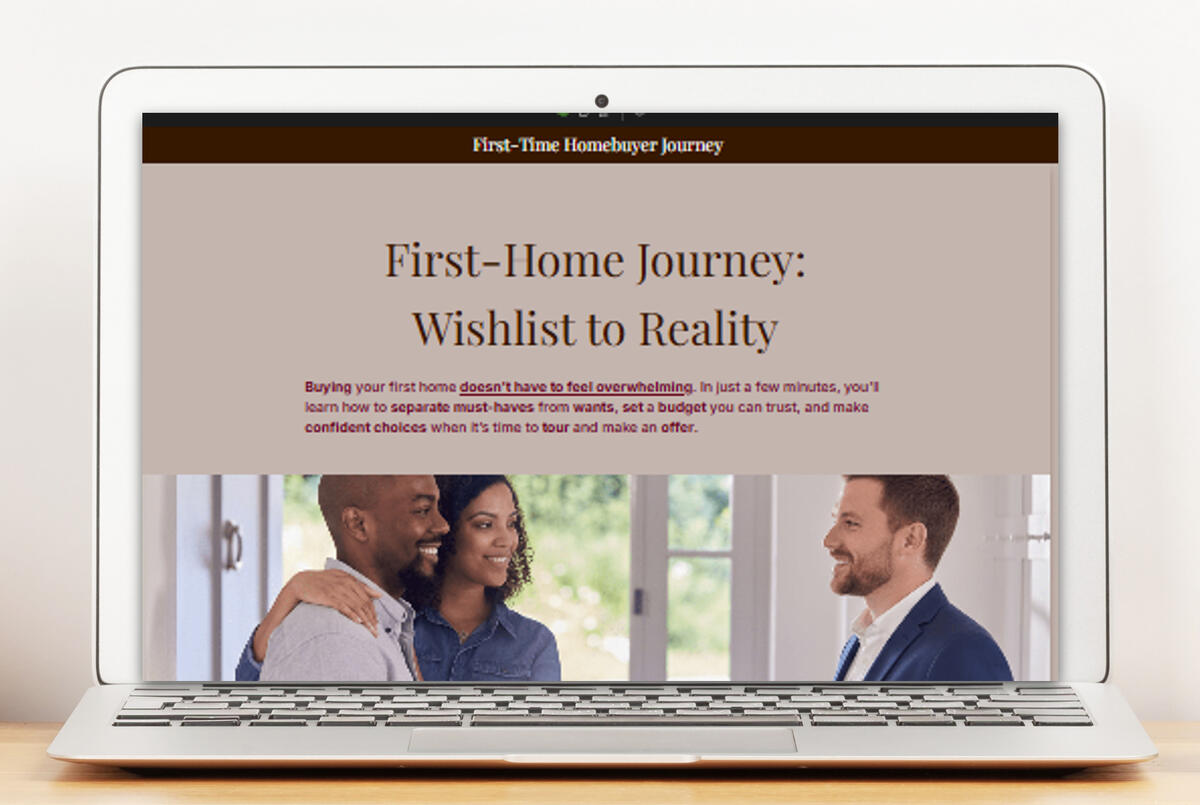
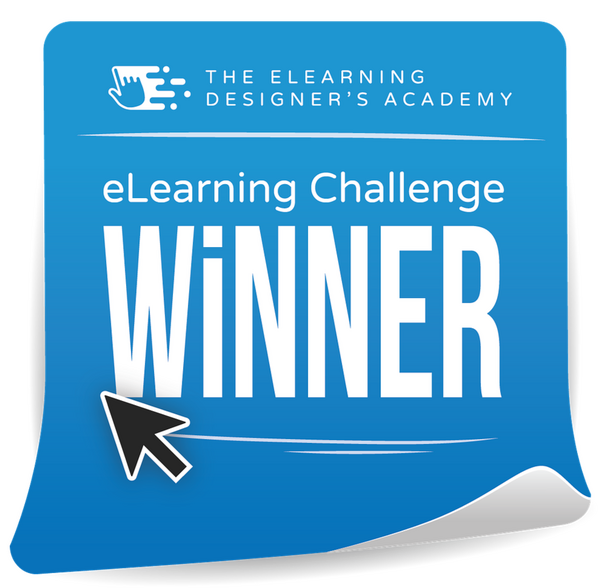
The Challenge
Vanderwell agents were spending too much time recalibrating first-time buyers who didn’t understand their own priorities, slowing down search timelines and complicating the offer process. Many clients entered the home search excited but overwhelmed — unclear on their budget, unsure how to distinguish needs from wants, and easily distracted by “HGTV features” that didn’t align with their lifestyle or price point.The brokerage needed a scalable, self-paced onboarding solution that could teach foundational concepts early, reduce repetitive explanations, and help clients approach property tours with confidence and clarity.
The Design
I created an interactive learning experience in Parta.io that blends practical instruction, visual exploration, and game-like decision-making. The entire course follows a “house under construction” theme: as learners progress, more pieces of the house appear, offering a sense of momentum without pressure.Each module gives buyers the space to practice real decisions they’ll face during a home search:Scenario-Based Practice
Multiple-choice cards and drag-and-drop interactions help learners sort through common dilemmas. Hints and supportive explanations guide them toward smarter choices without punitive feedback.Exploration Hotspots
Clickable floor plans, backyards, and room layouts reveal examples of essential features, nice-to-haves, hidden problems, and potential dealbreakers.HOA Coverage and Hidden Costs
Accordion-style reveals help clients distinguish between what HOAs actually cover, which hidden costs matter, and which “surprise expenses” can derail a budget.Budget & Closing Cost Tools
Interactive breakdowns help learners understand taxes, insurance, closing costs, and negotiating expenses. Reveal blocks show what happens when buyers skip inspections or stretch themselves financially.Negotiation Activity: Dealbreaker Drag
A custom Lovable-built activity (embedded in Parta.io) lets learners practice separating cosmetic issues from true dealbreakers in a safe, playful environment.Interactive Mortgage Calculator
A fully functional, Lovable Vibe-coded calculator guides learners through income, expenses, taxes, and loan terms. It generates a personalized affordability report with charts and uses Supabase to pull in real mortgage and property tax data.Dialogue Simulations
An AI-generated realtor character walks learners through offer scenarios, reinforcing mindset, decision-making, and realistic next steps.Downloadables & Badges
A Canva-designed first-time buyer checklist and animated Lottie badges acknowledge milestones and prepare buyers for discussions with their agent.
The Development
I built the full experience in Parta.io, combining stock interactions with custom-coded tools to bring the home buying process to life. Parta’s block-based flexibility allowed me to mix structured learning with exploratory elements, all tied together with Vanderwell’s brand colors and clean, modern visuals.The “Dealbreaker Drag” activity was created in Lovable with Tailwind CSS for responsive design and embedded into Parta.io. The mortgage calculator was developed using Supabase Edge Functions for real-time tax and loan data, producing individualized results inside the course.Visual assets came from Envato Elements and Canva, with consistent styling and accessibility features applied throughout. Every element was designed with WCAG-friendly colors, alt text, and predictable navigation.The tone of the course mirrors the guidance real agents provide: friendly, practical, and honest. The experience gives buyers a safe place to learn, make mistakes, and build confidence before stepping into actual showings.
Tools & Tech
Parta.io for course structure, hotspots, accordions, scenarios, and interactive content
Lovable or the Dealbreaker Drag activity and the interactive mortgage calculator, both embedded into Parta
Supabase for mortgage/tax calculations through Edge Functions
Tailwind CSS for responsive and accessible UI styling
Envato Elements for character assets and visuals
Canva for branded graphics and checklists
PowerPoint & Claud for badge interactions
ChatGPT for dialogue, content refinement, and scenario writing
The Result
This course transforms a static, text-heavy onboarding packet into an engaging, self-paced experience with meaningful, game-like practice. Buyers walk away with a clearer sense of their needs, wants, and budget — and a realistic understanding of how to evaluate homes and make an offer.Agents spend far less time explaining the basics and more time focusing on strategic guidance. Searches become more efficient, decisions become more grounded, and Vanderwell Realty strengthens its reputation as a tech-forward, client-centered brokerage.
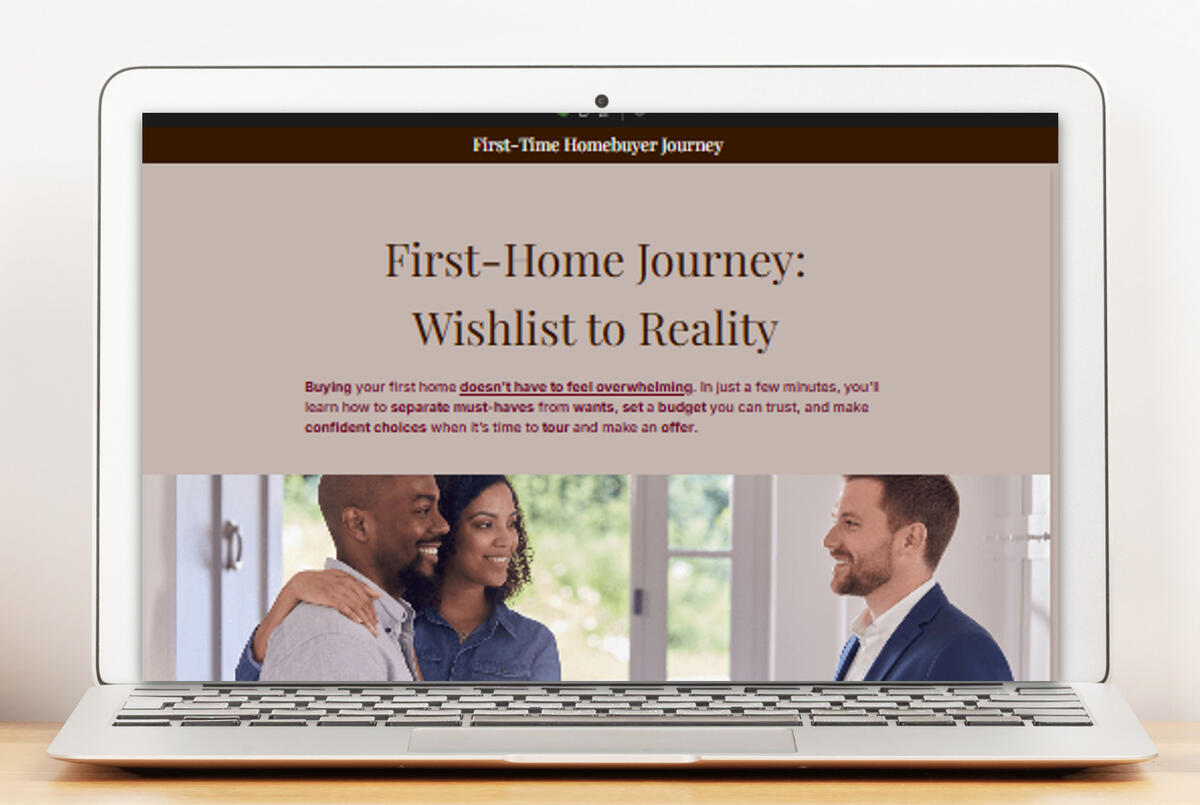
Copyright © 2025 | Designed by Tania Shenk | Texas
Contact
I’m actively seeking a full-time role in instructional design or learning development. I design training that’s clear, engaging, and aligned with real business goals. I’m also eager to connect with others in the field to share ideas and stay sharp on learning strategy and performance improvement.
Copyright © 2025 | Designed by Tania Shenk | Texas







